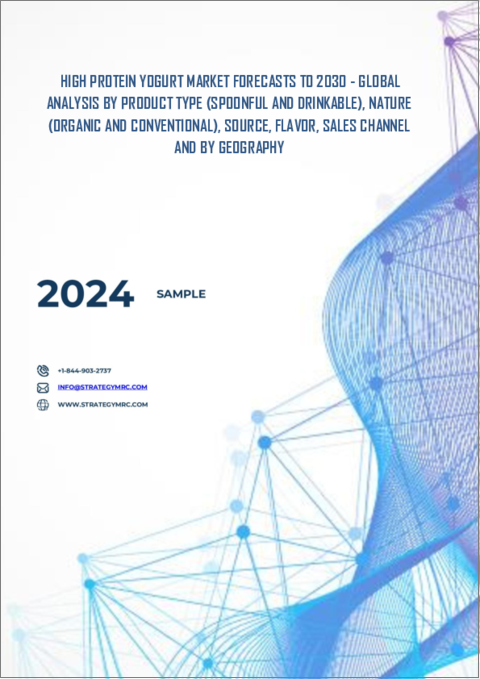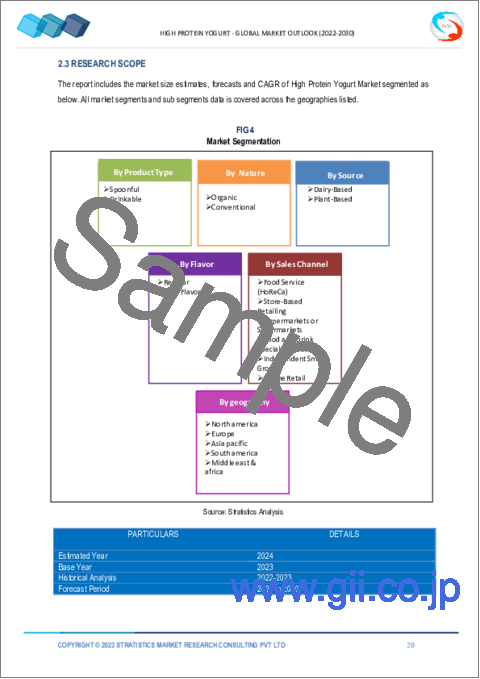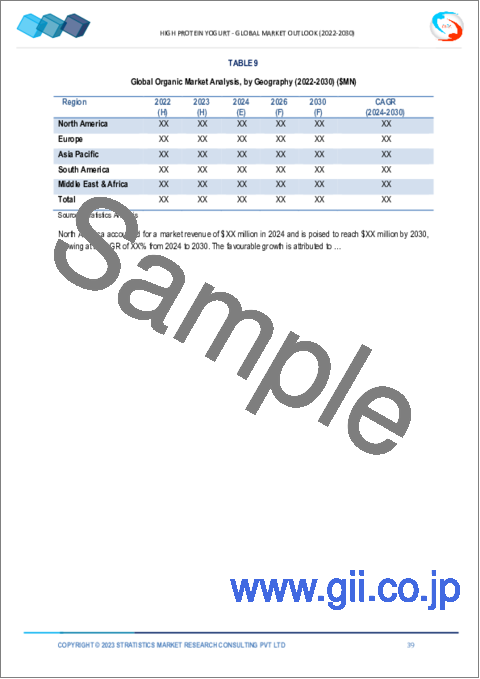|
|
市場調査レポート
商品コード
1587685
高たんぱくヨーグルト市場の2030年までの予測:製品タイプ、由来、原料、フレーバー、販売チャネル、地域別の世界分析High Protein Yogurt Market Forecasts to 2030 - Global Analysis By Product Type (Spoonful and Drinkable), Nature (Organic and Conventional), Source, Flavor, Sales Channel and by Geography |
||||||
カスタマイズ可能
|
|||||||
| 高たんぱくヨーグルト市場の2030年までの予測:製品タイプ、由来、原料、フレーバー、販売チャネル、地域別の世界分析 |
|
出版日: 2024年11月11日
発行: Stratistics Market Research Consulting
ページ情報: 英文 200+ Pages
納期: 2~3営業日
|
全表示
- 概要
- 図表
- 目次
Stratistics MRCによると、世界の高たんぱくヨーグルト市場は2024年に346億1,000万米ドルを占め、予測期間中のCAGRは4.86%で成長し、2030年には460億2,000万米ドルに達する見込みです。
栄養密度の高い乳製品である高たんぱくヨーグルトは、その多くの用途と健康上の利点から知名度が高まっています。通常、高タンパクヨーグルトは乳清タンパク質のようなタンパク質が豊富な原料を加えるか、通常のヨーグルトを漉してタンパク質を濃縮して作られます。従来のヨーグルトよりもタンパク質含有量が高いため、筋肉の成長や修復、身体機能全般を促進し、アスリートやフィットネス愛好家、タンパク質の摂取量を増やしたい人に最適です。高タンパクヨーグルトは、栄養価の高さだけでなく、さまざまな消費者の嗜好に合うよう、さまざまなフレーバーや形態で販売されています。
米国農務省(USDA)によると、ギリシャヨーグルトの平均的な1食分(150g)には約15gのタンパク質が含まれており、一般的なヨーグルトの1食分あたり6~9gを大きく上回っています。この高タンパク質含量が、健康志向の消費者の間でギリシャヨーグルトの人気を牽引する重要な要因となっています。
健康志向の消費者の動向
高たんぱくヨーグルトの市場は、消費者の健康とウェルネスに対する意識の高まりから大きな影響を受けています。人々の栄養に関する知識が増えるにつれ、高タンパク質含有量のような健康上のメリットを持つ製品の人気が高まっています。この傾向は、特にフィットネス愛好家やミレニアル世代に顕著で、彼らは活動的なライフスタイルを補完する食品を食べることに高い価値を置いています。さらに、より健康的な食生活へのシフトにより、高タンパク食品への需要が高まっており、高タンパクヨーグルトは栄養摂取量を増やそうとする人々に人気の選択肢となっています。
原料価格の変動
原材料の価格変動は、高たんぱくヨーグルト市場の大きな障壁となっています。高タンパクヨーグルトの製造には、牛乳、香料、タンパク源など様々な原材料が必要です。生産コストは、供給不足、気候変動、農業規制の変更などによって引き起こされる、これらの原材料の価格変動によって大きな影響を受ける可能性があります。価格が不安定な中で、メーカーが消費者に競合価格を提供しながら利益率を維持するのは難しいです。さらに、この分野での長期計画や投資の選択も、この不確実性によって影響を受ける可能性があります。
機能性食品への関心の高まり
高たんぱくヨーグルト製品は、機能性食品への動向によって大きなチャンスを手にしています。より多くの消費者が、消化器系の健康増進や活力の増加など、単なる栄養補給以上の健康上のメリットを提供する食品を求めるようになっています。プロバイオティクスやその他の健康成分が頻繁に強化されている高たんぱくヨーグルトは、このニーズによく応えています。さらに、これらの商品を機能性スナックとして宣伝することで、健康に気を遣っている顧客や特定の食事要件を担当している顧客を引き込むことができます。
消費者の嗜好と健康動向
消費者の嗜好や健康動向の変化は、高タンパク・ヨーグルト市場を脅かす可能性があります。現在、高タンパク製品の市場は非常に好調であるが、低タンパクまたは代替食へのシフトなど、食生活動向の変化により、高タンパクヨーグルトへの関心が低下する可能性があります。さらに、消費者は、糖分や人工添加物に関連した健康への懸念に対する意識が高まる結果、従来のヨーグルト製品に合わないより健康的な選択肢を求めるかもしれないです。製品ラインを適切に調整するために、ブランドはこうした動向を注視する必要があります。
COVID-19の影響:
消費者の行動と消費パターンの変化により、COVID-19の大流行は高たんぱくヨーグルト市場に大きな影響を与えました。多くの消費者の健康と免疫力が最優先事項となったため、健康的なスナックの選択肢としてよく考えられている高たんぱくヨーグルトのような栄養価の高い食品に対する需要は、パンデミック中に大幅に増加しました。パンデミックの初期段階は、食品サービス・チャネルとサプライ・チェーンに混乱を引き起こしながらも、家庭での消費とeコマース・プラットフォームへの移行を加速させました。さらに、食料品のオンライン・ショッピングが普及し、メーカーが顧客と直接コミュニケーションを取れるようになった。
予測期間中はスプーンフル・セグメントが最大になると予想される
高たんぱくヨーグルト市場では、スプーン一杯セグメントが最大のシェアを占めています。カップやチューブのような伝統的なヨーグルトのフォーマットは、ヨーグルト消費に対する確立された消費者の嗜好に適しており、このセグメントに含まれます。様々な食習慣に簡単に適合する便利で栄養価の高い選択肢で、スプーン一杯のカテゴリーは幅広い顧客にサービスを提供しています。風味と栄養価の両方を提供できることから、スプーンフル・セグメントは健康志向の消費者の間で高まる高タンパク質スナックの需要から利益を得ています。さらに、ヨーグルトは柔軟性のある食事やスナックの材料として人気が高まっているため、市場での地位が強化され、高たんぱくヨーグルト産業の拡大を支える主要な力として位置づけられています。
フルーツ風味セグメントは予測期間中に最も高いCAGRが見込まれる
高たんぱくヨーグルト市場では、フルーツフレーバー分野が最も高いCAGRで成長すると予測されます。特に若年層や健康志向の高い人々の間で、味と魅力を向上させるフレーバーヨーグルトの選択肢に対する消費者の嗜好が高まっていることが、この市場セグメントの成長につながった。フルーツ風味の高たんぱくヨーグルトは、健康とウェルビーイングに関連することが多いフルーツの利点を付加することで、通常の食生活にタンパク質を加えるおいしい方法を提供します。さらに、消費者が風味を犠牲にすることなく健康目的を満たす製品を求めているため、この市場の成長は、新しい風味の組み合わせの導入や天然成分の使用によっても促進されています。
最大のシェアを持つ地域:
高たんぱくヨーグルト市場は北米地域が支配的です。健康志向の製品に対する消費者の強い嗜好と、タンパク質を添加した乳製品に対する需要の高まりが、この優位性の主な原因です。同地域の長年にわたるヨーグルト消費文化と高タンパク質食への傾向の高まりにより、伝統的なスプーンタイプも便利なドリンクタイプも好調な売れ行きを示しています。さらに、北米は栄養価の高い製品を提供することに力を注いでおり、消費者の嗜好や食事に関する様々な要件に対応する多様な製品ラインナップが、世界の高たんぱくヨーグルト市場の形成において同地域が重要な役割を担っていることを浮き彫りにしています。
CAGRが最も高い地域:
高たんぱくヨーグルト市場は、欧州地域で最も高いCAGRで成長すると予想されます。欧州の消費者の栄養と健康に対する意識が高まり続けているため、健康を意識した乳製品に対する需要が強いです。市場の多様性により、国によって栄養要件や味の嗜好が異なります。各ブランドは、地域の嗜好に合わせた斬新なフレーバーや配合を導入しています。さらに、欧州の新興市場は、より便利で栄養密度の高い選択肢を求める教育水準の高い消費者層に対応しており、同地域を世界の高たんぱくヨーグルト市場における主要プレーヤーにしています。
無料のカスタマイズサービス:
本レポートをご購読のお客様には、以下の無料カスタマイズオプションのいずれかをご利用いただけます:
- 企業プロファイル
- 追加市場プレイヤーの包括的プロファイリング(3社まで)
- 主要企業のSWOT分析(3社まで)
- 地域セグメンテーション
- 顧客の関心に応じた主要国の市場推計・予測・CAGR(注:フィージビリティチェックによる)
- 競合ベンチマーキング
- 製品ポートフォリオ、地理的プレゼンス、戦略的提携に基づく主要企業のベンチマーキング
目次
第1章 エグゼクティブサマリー
第2章 序文
- 概要
- ステークホルダー
- 調査範囲
- 調査手法
- データマイニング
- データ分析
- データ検証
- 調査アプローチ
- 調査情報源
- 1次調査情報源
- 2次調査情報源
- 前提条件
第3章 市場動向分析
- 促進要因
- 抑制要因
- 機会
- 脅威
- 製品分析
- 新興市場
- COVID-19の影響
第4章 ポーターのファイブフォース分析
- 供給企業の交渉力
- 買い手の交渉力
- 代替品の脅威
- 新規参入業者の脅威
- 競争企業間の敵対関係
第5章 世界の高タンパクヨーグルト市場:製品タイプ別
- 食べるヨーグルト(スプーンフル)
- 飲むヨーグルト
第6章 世界の高タンパクヨーグルト市場:由来別
- オーガニック
- 従来型
第7章 世界の高タンパクヨーグルト市場:原料別
- 乳製品ベース
- 植物由来
- 豆乳
- アーモンドミルク
- ココナッツミルク
- その他
第8章 世界の高タンパクヨーグルト市場:フレーバー別
- 通常
- フルーツ風味
- りんご
- バナナ
- ブルーベリー
- バニラ
- チョコレート
- いちご
- マンゴー
- ブラックカラント
第9章 世界の高タンパクヨーグルト市場:販売チャネル別
- フードサービス(HoReCa)
- 店舗型小売業
- ハイパーマーケットまたはスーパーマーケット
- 食品・飲料専門店
- 独立系小規模食料品店
- オンライン小売
第10章 世界の高タンパクヨーグルト市場:地域別
- 北米
- 米国
- カナダ
- メキシコ
- 欧州
- ドイツ
- 英国
- イタリア
- フランス
- スペイン
- その他欧州
- アジア太平洋
- 日本
- 中国
- インド
- オーストラリア
- ニュージーランド
- 韓国
- その他アジア太平洋地域
- 南米
- アルゼンチン
- ブラジル
- チリ
- その他南米
- 中東・アフリカ
- サウジアラビア
- アラブ首長国連邦
- カタール
- 南アフリカ
- その他中東とアフリカ
第11章 主な発展
- 契約、パートナーシップ、コラボレーション、合弁事業
- 買収と合併
- 新製品発売
- 事業拡大
- その他の主要戦略
第12章 企業プロファイリング
- Koninklijke DSM N.V.
- Danone S.A.
- FAGE International S.A.
- Epi Ingredients
- General Mills, Inc
- Maple Hill Creamery
- Stonyfield Farm, Inc.
- Chobani LLC
- Oikos
- Yeo Valley
List of Tables
- Table 1 Global High Protein Yogurt Market Outlook, By Region (2022-2030) ($MN)
- Table 2 Global High Protein Yogurt Market Outlook, By Product Type (2022-2030) ($MN)
- Table 3 Global High Protein Yogurt Market Outlook, By Spoonful (2022-2030) ($MN)
- Table 4 Global High Protein Yogurt Market Outlook, By Drinkable (2022-2030) ($MN)
- Table 5 Global High Protein Yogurt Market Outlook, By Nature (2022-2030) ($MN)
- Table 6 Global High Protein Yogurt Market Outlook, By Organic (2022-2030) ($MN)
- Table 7 Global High Protein Yogurt Market Outlook, By Conventional (2022-2030) ($MN)
- Table 8 Global High Protein Yogurt Market Outlook, By Source (2022-2030) ($MN)
- Table 9 Global High Protein Yogurt Market Outlook, By Dairy-Based (2022-2030) ($MN)
- Table 10 Global High Protein Yogurt Market Outlook, By Plant-Based (2022-2030) ($MN)
- Table 11 Global High Protein Yogurt Market Outlook, By Soy milk (2022-2030) ($MN)
- Table 12 Global High Protein Yogurt Market Outlook, By Almond milk (2022-2030) ($MN)
- Table 13 Global High Protein Yogurt Market Outlook, By Coconut milk (2022-2030) ($MN)
- Table 14 Global High Protein Yogurt Market Outlook, By Others (2022-2030) ($MN)
- Table 15 Global High Protein Yogurt Market Outlook, By Flavor (2022-2030) ($MN)
- Table 16 Global High Protein Yogurt Market Outlook, By Regular (2022-2030) ($MN)
- Table 17 Global High Protein Yogurt Market Outlook, By Fruit Flavored (2022-2030) ($MN)
- Table 18 Global High Protein Yogurt Market Outlook, By Apple (2022-2030) ($MN)
- Table 19 Global High Protein Yogurt Market Outlook, By Banana (2022-2030) ($MN)
- Table 20 Global High Protein Yogurt Market Outlook, By Blueberry (2022-2030) ($MN)
- Table 21 Global High Protein Yogurt Market Outlook, By Vanilla (2022-2030) ($MN)
- Table 22 Global High Protein Yogurt Market Outlook, By Chocolate (2022-2030) ($MN)
- Table 23 Global High Protein Yogurt Market Outlook, By Strawberry (2022-2030) ($MN)
- Table 24 Global High Protein Yogurt Market Outlook, By Mango (2022-2030) ($MN)
- Table 25 Global High Protein Yogurt Market Outlook, By Blackcurrant (2022-2030) ($MN)
- Table 26 Global High Protein Yogurt Market Outlook, By Sales Channel (2022-2030) ($MN)
- Table 27 Global High Protein Yogurt Market Outlook, By Food Service (HoReCa) (2022-2030) ($MN)
- Table 28 Global High Protein Yogurt Market Outlook, By Store-Based Retailing (2022-2030) ($MN)
- Table 29 Global High Protein Yogurt Market Outlook, By Hypermarkets or Supermarkets (2022-2030) ($MN)
- Table 30 Global High Protein Yogurt Market Outlook, By Food and Drink Specialty Stores (2022-2030) ($MN)
- Table 31 Global High Protein Yogurt Market Outlook, By Independent Small Grocery (2022-2030) ($MN)
- Table 32 Global High Protein Yogurt Market Outlook, By Online Retail (2022-2030) ($MN)
Note: Tables for North America, Europe, APAC, South America, and Middle East & Africa Regions are also represented in the same manner as above.
According to Stratistics MRC, the Global High Protein Yogurt Market is accounted for $34.61 billion in 2024 and is expected to reach $46.02 billion by 2030 growing at a CAGR of 4.86% during the forecast period. A nutrient-dense dairy product, high-protein yogurt has become more well-known because of its many uses and health advantages. Usually, it is made by adding protein-rich ingredients like whey protein or by straining ordinary yogurt to concentrate the protein. Its higher protein content than traditional yogurt promotes muscle growth, repair, and general bodily function, making it a great choice for athletes, fitness enthusiasts, and anyone looking to up their protein intake. High-protein yogurt is available in a variety of flavors and formats to suit a range of consumer preferences in addition to its nutritional value.
According to the U.S. Department of Agriculture (USDA), an average serving of Greek yogurt (150g) contains around 15g of protein, significantly higher than regular yogurt, which typically provides 6-9g per serving. This high protein content is a key factor driving its popularity among health-conscious consumers.
Market Dynamics:
Driver:
Trends in health-conscious consumers
The market for high-protein yogurt is significantly influenced by consumers increasing awareness of health and wellness. Products with health benefits, like high protein content, are becoming more and more popular as people's knowledge of nutrition increases. This tendency is especially noticeable among fitness enthusiasts and millennial, who place a high value on eating foods that complement their active lifestyles. Additionally, the demand for high-protein foods has increased due to the shift towards healthier eating habits, making high-protein yogurt a popular choice for people trying to increase their nutritional intake.
Restraint:
Price fluctuations for raw materials
Price fluctuations for raw materials are a major barrier to the market for high-protein yogurt. A variety of ingredients, such as milk, flavorings, and protein sources, are needed to produce high-protein yogurt. Production costs can be greatly impacted by price volatility for these raw materials, which can be brought on by things like supply shortages, climate change, or modifications to agricultural regulations. It is difficult for manufacturers to maintain profit margins while providing consumers with competitive pricing when prices are unstable. Furthermore, long-term planning and investment choices made within the sector may also be impacted by this uncertainty.
Opportunity:
Growing interest in functional foods
High-protein yogurt products have a big chance owing to the trend toward functional foods. More and more consumers are looking for foods that offer health advantages beyond simple sustenance, like better digestive health or increased vitality. This need is well met by high-protein yogurt, which is frequently enhanced with probiotics and other healthy components. Moreover, promoting these goods as functional snacks can aid in drawing in customers who are concerned about their health and who are in charge of particular dietary requirements.
Threat:
Consumer preferences and health trends
Consumer preferences and changes in health trends could threaten the market for high-protein yogurt. Although the market for high-protein products is currently very strong, shifts in dietary trends, such as a shift to lower-protein or alternative diets, may cause interest in high-protein yogurt to decline. Furthermore, consumers may look for healthier options that do not fit with the conventional yogurt offerings as a result of growing awareness of health concerns associated with sugar content or artificial additives. To adjust their product lines appropriately, brands need to keep a close eye on these trends.
Covid-19 Impact:
Due to changes in consumer behaviour and consumption patterns, the COVID-19 pandemic had a major effect on the market for high-protein yogurt. Demand for nutrient-rich foods, such as high-protein yogurt, which is frequently thought of as a healthy snack option, significantly increased during the pandemic as many consumers' health and immunity became top priorities. The early stages of the pandemic sped up the transition to home consumption and e-commerce platforms, even as they caused disruptions in foodservice channels and supply chains. Moreover, online grocery shopping has become more popular, giving manufacturers a direct line of communication with their clientele.
The Spoonful segment is expected to be the largest during the forecast period
In the market for high-protein yogurt, the Spoonful segment holds the largest share. Traditional yogurt formats, like cups and tubs that suit well-established consumer preferences for yogurt consumption are included in this segment. With a convenient and nourishing option that easily fits into a variety of dietary habits, the Spoonful category serves a broad clientele. Due to its capacity to provide both flavor and nutritional value, the Spoonful segment benefits from the growing demand for high-protein snacks among health-conscious consumers. Furthermore, yogurt's growing popularity as a flexible meal and snack ingredient strengthens its place in the market and positions it as a major force behind the expansion of the high-protein yogurt industry.
The Fruit Flavored segment is expected to have the highest CAGR during the forecast period
In the market for high-protein yogurt, the fruit-flavored segment is anticipated to grow at the highest CAGR. The growing consumer preference for flavored yogurt options that improve taste and appeal especially among younger demographics and health-conscious individuals has led to the growth of this market segment. With the added benefit of fruit, which is frequently linked to health and wellbeing, fruit-flavored high-protein yogurts provide a tasty way to add protein to regular diets. Additionally, growth in this market is also being fuelled by the introduction of novel flavour combinations and the use of natural ingredients, as consumers look for products that satisfy their health objectives without sacrificing flavour.
Region with largest share:
The market for high-protein yogurt is dominated by the North American region. Strong consumer preferences for health-conscious products and rising demand for dairy products with added protein are the main causes of this dominance. Both traditional spoonful formats and convenient drinkable options have seen strong sales due to the region's long-standing yogurt consumption culture and the growing trend toward high-protein diets. Furthermore, North America's dedication to nutritional offerings and a varied product landscape that accommodates a range of consumer tastes and dietary requirements highlight the region's crucial role in forming the global high-protein yogurt market.
Region with highest CAGR:
The high-protein yogurt market is expected to grow at the highest CAGR in the Europe region. As European consumers' awareness of nutrition and wellness continues to grow, there is a strong demand for dairy products that are health-conscious. Due to the market's diversity, different countries have different nutritional requirements and taste preferences. Brands are introducing novel flavors and formulations that cater to regional preferences. Moreover, Europe's developed market caters to a well-educated consumer base that is looking for more convenient and nutrient-dense options, making the region a major player in the global high-protein yogurt market.
Key players in the market
Some of the key players in High Protein Yogurt market include Koninklijke DSM N.V., Danone S.A., FAGE International S.A., Epi Ingredients, General Mills, Inc, Maple Hill Creamery, Stonyfield Farm, Inc., Chobani LLC, Oikos and Yeo Valley.
Key Developments:
In September 2024, General Mills, Inc. announced that it has entered into definitive agreements to sell its North American Yogurt business to Lactalis and Sodiaal, two leading French dairy companies, in cash transactions valued at an aggregate $2.1 billion USD.
In July 2024, Maple Hill Creamery announced its expansion with the addition of new farms located in Central Pennsylvania and greater Lancaster County. This growth marks a significant milestone in Maple Hill Creamery's commitment to providing high-quality, 100% grass-fed organic dairy products to consumers while supporting sustainable and regenerative farming practices.
In January 2024, French food group Danone, opens new tab said that it had signed an agreement to sell its premium organic dairy units in the United States to investment firm Platinum Equity. The sale of the Horizon Organic and Wallaby businesses is part of the company's portfolio review and asset rotation program the company announced in March 2022, Danone said in a statement, without disclosing the financial details of the deal.
Product Types Covered:
- Spoonful
- Drinkable
Natures Covered:
- Organic
- Conventional
Sources Covered:
- Dairy-Based
- Plant-Based
Flavors Covered:
- Regular
- Fruit Flavored
Sales Channels Covered:
- Food Service (HoReCa)
- Store-Based Retailing
- Hypermarkets or Supermarkets
- Food and Drink Specialty Stores
- Independent Small Grocery
- Online Retail
Regions Covered:
- North America
- US
- Canada
- Mexico
- Europe
- Germany
- UK
- Italy
- France
- Spain
- Rest of Europe
- Asia Pacific
- Japan
- China
- India
- Australia
- New Zealand
- South Korea
- Rest of Asia Pacific
- South America
- Argentina
- Brazil
- Chile
- Rest of South America
- Middle East & Africa
- Saudi Arabia
- UAE
- Qatar
- South Africa
- Rest of Middle East & Africa
What our report offers:
- Market share assessments for the regional and country-level segments
- Strategic recommendations for the new entrants
- Covers Market data for the years 2022, 2023, 2024, 2026, and 2030
- Market Trends (Drivers, Constraints, Opportunities, Threats, Challenges, Investment Opportunities, and recommendations)
- Strategic recommendations in key business segments based on the market estimations
- Competitive landscaping mapping the key common trends
- Company profiling with detailed strategies, financials, and recent developments
- Supply chain trends mapping the latest technological advancements
Free Customization Offerings:
All the customers of this report will be entitled to receive one of the following free customization options:
- Company Profiling
- Comprehensive profiling of additional market players (up to 3)
- SWOT Analysis of key players (up to 3)
- Regional Segmentation
- Market estimations, Forecasts and CAGR of any prominent country as per the client's interest (Note: Depends on feasibility check)
- Competitive Benchmarking
- Benchmarking of key players based on product portfolio, geographical presence, and strategic alliances
Table of Contents
1 Executive Summary
2 Preface
- 2.1 Abstract
- 2.2 Stake Holders
- 2.3 Research Scope
- 2.4 Research Methodology
- 2.4.1 Data Mining
- 2.4.2 Data Analysis
- 2.4.3 Data Validation
- 2.4.4 Research Approach
- 2.5 Research Sources
- 2.5.1 Primary Research Sources
- 2.5.2 Secondary Research Sources
- 2.5.3 Assumptions
3 Market Trend Analysis
- 3.1 Introduction
- 3.2 Drivers
- 3.3 Restraints
- 3.4 Opportunities
- 3.5 Threats
- 3.6 Product Analysis
- 3.7 Emerging Markets
- 3.8 Impact of Covid-19
4 Porters Five Force Analysis
- 4.1 Bargaining power of suppliers
- 4.2 Bargaining power of buyers
- 4.3 Threat of substitutes
- 4.4 Threat of new entrants
- 4.5 Competitive rivalry
5 Global High Protein Yogurt Market, By Product Type
- 5.1 Introduction
- 5.2 Spoonful
- 5.3 Drinkable
6 Global High Protein Yogurt Market, By Nature
- 6.1 Introduction
- 6.2 Organic
- 6.3 Conventional
7 Global High Protein Yogurt Market, By Source
- 7.1 Introduction
- 7.2 Dairy-Based
- 7.3 Plant-Based
- 7.3.1 Soy milk
- 7.3.2 Almond milk
- 7.3.3 Coconut milk
- 7.3.4 Others
8 Global High Protein Yogurt Market, By Flavor
- 8.1 Introduction
- 8.2 Regular
- 8.3 Fruit Flavored
- 8.3.1 Apple
- 8.3.2 Banana
- 8.3.3 Blueberry
- 8.3.4 Vanilla
- 8.3.5 Chocolate
- 8.3.6 Strawberry
- 8.3.7 Mango
- 8.3.8 Blackcurrant
9 Global High Protein Yogurt Market, By Sales Channel
- 9.1 Introduction
- 9.2 Food Service (HoReCa)
- 9.3 Store-Based Retailing
- 9.4 Hypermarkets or Supermarkets
- 9.5 Food and Drink Specialty Stores
- 9.6 Independent Small Grocery
- 9.7 Online Retail
10 Global High Protein Yogurt Market, By Geography
- 10.1 Introduction
- 10.2 North America
- 10.2.1 US
- 10.2.2 Canada
- 10.2.3 Mexico
- 10.3 Europe
- 10.3.1 Germany
- 10.3.2 UK
- 10.3.3 Italy
- 10.3.4 France
- 10.3.5 Spain
- 10.3.6 Rest of Europe
- 10.4 Asia Pacific
- 10.4.1 Japan
- 10.4.2 China
- 10.4.3 India
- 10.4.4 Australia
- 10.4.5 New Zealand
- 10.4.6 South Korea
- 10.4.7 Rest of Asia Pacific
- 10.5 South America
- 10.5.1 Argentina
- 10.5.2 Brazil
- 10.5.3 Chile
- 10.5.4 Rest of South America
- 10.6 Middle East & Africa
- 10.6.1 Saudi Arabia
- 10.6.2 UAE
- 10.6.3 Qatar
- 10.6.4 South Africa
- 10.6.5 Rest of Middle East & Africa
11 Key Developments
- 11.1 Agreements, Partnerships, Collaborations and Joint Ventures
- 11.2 Acquisitions & Mergers
- 11.3 New Product Launch
- 11.4 Expansions
- 11.5 Other Key Strategies
12 Company Profiling
- 12.1 Koninklijke DSM N.V.
- 12.2 Danone S.A.
- 12.3 FAGE International S.A.
- 12.4 Epi Ingredients
- 12.5 General Mills, Inc
- 12.6 Maple Hill Creamery
- 12.7 Stonyfield Farm, Inc.
- 12.8 Chobani LLC
- 12.9 Oikos
- 12.10 Yeo Valley






